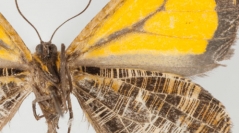

 European Journal of Taxonomy
2018 (404) - Pages 1-54
European Journal of Taxonomy
2018 (404) - Pages 1-54The vividly coloured Neotropical genus Callipia Guenée (1858) (Lepidoptera Linnaeus, 1758, Geometridae (Leach, 1815), Larentiinae (Leach, 1815), Stamnodini Forbes, 1948) is revised and separated into four species groups, according to a provisional phylogeny based on Cytochrome Oxidase I (COI) gene data and morphology. Fourteen new species are described using COI data and morphology: a) in the balteata group: C. fiedleri sp. nov., C. jakobi sp. nov., C. lamasi sp. nov.; b) in the vicinaria group: C. hausmanni sp. nov., C. walterfriedlii sp. nov.; c) in the parrhasiata group: C. augustae sp. nov., C. jonai sp. nov., C. karsholti sp. nov., C. levequei sp. nov., C. milleri sp. nov., C. sihvoneni sp. nov., C. wojtusiaki sp. nov. and d) in the constantinaria group: C. hiltae sp. nov., C. rougeriei sp. nov. One new subspecies is described: C. wojtusiaki septentrionalis subsp. nov. Two species are revived from synonymy: C. intermedia Dognin, 1914 stat. rev. and C. occulta Warren, 1904 stat. rev. The taxon hamaria Sperry, 1951 is transferred from being a junior synonym of C. constantinaria Oberthür, 1881 to being a junior synonym of C. occulta stat. rev. The taxon admirabilis Warren, 1904 is confirmed as being a junior synonym of C. paradisea Thierry-Mieg, 1904. The taxon languescens Warren, 1904 is confirmed as being a junior synonym of C. rosetta, Thierry-Mieg, 1904 and the taxon confluens Warren, 1905 is confirmed as being a junior synonym of C. balteata Warren, 1905. The status of the remaining species is not changed: C. aurata Warren, 1904, C. brenemanae Sperry, 1951, C. parrhasiata Guenée, 1858, C. flagrans Warren, 1904, C. fulvida Warren, 1907 and C. vicinaria Dognin. All here recognised 28 species are illustrated and the available molecular genetic information of 27 species, including Barcode Index Numbers (BINs) for most of the taxa is provided. The almost threefold increase from 10 to 28 valid species shows that species richness of tropical moths is strongly underestimated even in relatively conspicuous taxa. Callipia occurs from medium to high elevations in wet parts of the tropical and subtropical Andes from Colombia to northern Argentina. The early stages and host plants are still unknown.
Callipia, taxonomy, Andes, insect, Neotropics.